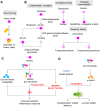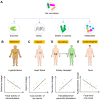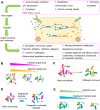Targeting gut microbiota for precision medicine: Focusing on the efficacy and toxicity of drugs
- PMID: 33042283
- PMCID: PMC7532689
- DOI: 10.7150/thno.47289
Targeting gut microbiota for precision medicine: Focusing on the efficacy and toxicity of drugs
Abstract
Intra- and interindividual variation in drug responses is one major reason for the failure of drug therapy, drug toxicity, and even the death of patients. Precision medicine, or personalized medicine, is a field of medicine that customizes an individual's medical diagnosis and treatment based on his/her genes, microbiomes, environments, etc. Over the past decade, a large number of studies have demonstrated that gut microbiota can modify the efficacy and toxicity of drugs, and the extent of the modification varies greatly from person to person because of the variability of the gut microbiota. Personalized manipulation of gut microbiota is an important approach to rectify the abnormal drug response. In this review, we aim to improve drug efficacy and reduce drug toxicity by combining precision medicine and gut microbiota. After describing the interactions between gut microbiota and xenobiotics, we discuss (1) the effects of gut microbiota on drug efficacy and toxicity and the corresponding mechanisms, (2) the variability of gut microbiota, which leads to variation in drug responses, (3) the biomarkers used for the patient stratification and treatment decisions before the use of drugs, and (4) the methods used for the personalized manipulation of gut microbiota to improve drug outcomes. Overall, we hope to improve the drug response by incorporating the knowledge of gut microbiota into clinical practice.
Keywords: drug efficacy; drug toxicity; gut bacteria engineering; gut microbiota; precision medicine.
© The author(s).
Conflict of interest statement
Competing Interests: The authors have declared that no competing interest exists.
Figures








Similar articles
-
Gut Reactions: Breaking Down Xenobiotic-Microbiome Interactions.Pharmacol Rev. 2019 Apr;71(2):198-224. doi: 10.1124/pr.118.015768. Pharmacol Rev. 2019. PMID: 30890566 Review.
-
Connecting the dots: Targeting the microbiome in drug toxicity.Med Res Rev. 2022 Jan;42(1):83-111. doi: 10.1002/med.21805. Epub 2021 Apr 15. Med Res Rev. 2022. PMID: 33856076 Review.
-
Gut microbiota as a target to limit toxic effects of traditional Chinese medicine: Implications for therapy.Biomed Pharmacother. 2021 Jan;133:111047. doi: 10.1016/j.biopha.2020.111047. Epub 2020 Dec 4. Biomed Pharmacother. 2021. PMID: 33378954 Review.
-
Precision Medicine Goes Microscopic: Engineering the Microbiome to Improve Drug Outcomes.Cell Host Microbe. 2019 Jul 10;26(1):22-34. doi: 10.1016/j.chom.2019.06.011. Cell Host Microbe. 2019. PMID: 31295421 Free PMC article. Review.
-
The Role of the Gut Microbiome in Predicting Response to Diet and the Development of Precision Nutrition Models. Part II: Results.Adv Nutr. 2019 Nov 1;10(6):979-998. doi: 10.1093/advances/nmz049. Adv Nutr. 2019. PMID: 31225587 Free PMC article. Review.
Cited by
-
Aqueous extracts of Aconite promote thermogenesis in rats with hypothermia via regulating gut microbiota and bile acid metabolism.Chin Med. 2021 Mar 19;16(1):29. doi: 10.1186/s13020-021-00437-y. Chin Med. 2021. PMID: 33741035 Free PMC article.
-
Dietary compounds in modulation of gut microbiota-derived metabolites.Front Nutr. 2022 Jul 19;9:939571. doi: 10.3389/fnut.2022.939571. eCollection 2022. Front Nutr. 2022. PMID: 35928846 Free PMC article. Review.
-
Tree peony seed oil alleviates hyperlipidemia and hyperglycemia by modulating gut microbiota and metabolites in high-fat diet mice.Food Sci Nutr. 2024 Apr 4;12(6):4421-4434. doi: 10.1002/fsn3.4108. eCollection 2024 Jun. Food Sci Nutr. 2024. PMID: 38873446 Free PMC article.
-
MagMD: Database summarizing the metabolic action of gut microbiota to drugs.Comput Struct Biotechnol J. 2022 Nov 12;20:6427-6430. doi: 10.1016/j.csbj.2022.11.021. eCollection 2022. Comput Struct Biotechnol J. 2022. PMID: 36467581 Free PMC article.
-
Diabetes Mellitus and Gastric Cancer: Correlation and Potential Mechanisms.J Diabetes Res. 2023 Nov 9;2023:4388437. doi: 10.1155/2023/4388437. eCollection 2023. J Diabetes Res. 2023. PMID: 38020199 Free PMC article. Review.
References
-
- Wilkinson GR. Drug metabolism and variability among patients in drug response. N Engl J Med. 2005;352:2211–21. - PubMed
-
- Spear BB, Heath-Chiozzi M, Huff J. Clinical application of pharmacogenetics. Trends Mol Med. 2001;7:201–4. - PubMed
-
- Budnitz DS, Lovegrove MC, Crosby AE. Emergency department visits for overdoses of acetaminophen-containing products. Am J Prev Med. 2011;40:585–92. - PubMed
-
- Blieden M, Paramore LC, Shah D, Ben-Joseph R. A perspective on the epidemiology of acetaminophen exposure and toxicity in the United States. Expert Rev Clin Pharmacol. 2014;7:341–8. - PubMed
Publication types
MeSH terms
Substances
LinkOut - more resources
Full Text Sources
Medical
Miscellaneous

